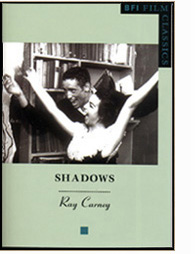|
 "Ray
Carney is a tireless researcher who probably knows more about the
shooting of Shadows than any other living being, including Cassavetes
when he was alive, since Carney, after all, has the added input
of ten or more of the film’s participants who remember their own
unique versions of the reality we all shared.’
—Maurice
McEndree, producer and editor of Shadows "Ray
Carney is a tireless researcher who probably knows more about the
shooting of Shadows than any other living being, including Cassavetes
when he was alive, since Carney, after all, has the added input
of ten or more of the film’s participants who remember their own
unique versions of the reality we all shared.’
—Maurice
McEndree, producer and editor of Shadows
"Bravo!
Cassavetes is fortunate to have such a diligent champion. I am absolutely
dumbfounded by the depth of your research into this film.... Your
appendix...is a definitive piece of scholarly detective work....
The Robert Aurthur revelation is another bombshell and only leaves
me wanting to know more.... The book movingly captures the excitement
and dynamic Cassavetes discovered in filmmaking; and the perseverance
and struggle of getting it up there on the screen." —Tom
Charity,
Film Editor, Time
Out magazine
***
John Cassavetes’ Shadows is
generally regarded as the start of the independent feature movement
in America. Made for $40,000 with a nonprofessional cast and crew
and borrowed equipment, the film caused a sensation on its London
release in 1960.
The film traces the lives of three
siblings in an African-American family: Hugh, a struggling jazz
singer, attempting to obtain a job and hold onto his dignity; Ben,
a Beat drifter who goes from one fight and girlfriend to another;
and Lelia, who has a brief love affair with a white boy who turns
on her when he discovers her race. In a delicate, semi-comic drama
of self-discovery, the main characters are forced to explore who
they are and what really matters in their lives.
Shadows ends with the title
card "The film you have just seen was an improvisation," and
for
decades was hailed as a masterpiece of spontaneity, but shortly
before Cassavetes’ death, he confessed to Ray Carney something
he
had never before revealed – that much of the film was scripted.
He
told him that it was shot twice and that the scenes in the second
version were written by him and Robert Alan Aurthur, a professional
Hollywood screenwriter. For Carney, it was Cassavetes‘ Rosebud.
He spent ten years tracking down the surviving members of the cast
and crew, and piecing together the true story of the making of
the
film.
Carney takes the reader behind the
scenes to follow every step in the making of the movie – chronicling
the hopes and dreams, the struggles and frustrations, and the ultimate
triumph of the collaboration that resulted in one of the seminal
masterworks of American independent filmmaking.
Highlights of the presentation are
more than 30 illustrations (including the only existing photographs
of the dramatic workshop Cassavetes ran in the late fifties and
of the stage on which much of Shadows was shot, and a still
showing a scene from the "lost" first version of the film); and
statements by many of the film’s actors and crew members detailing
previously unknown events during its creation.
One of the most interesting and original
aspects of the book is a nine-page Appendix that "reconstructs"
much of the lost first version of the film for the first time.
The
Appendix points out more than 100 previously unrecognized differences
between the 1957 and 1959 shoots, all of which are identified in
detail both by the scene and the time at which they occur in the
current print of the movie (so that they may be easily located
on
videotape or DVD by anyone viewing the film).
By comparing the two versions, the
Appendix allows the reader to eavesdrop on Cassavetes’ process of
revision and watch his mind at work as he re-thought, re-shot, re-edited
his movie. None of this information, which Carney spent more than
five years compiling, has ever appeared in print before (and, as
the presentation reveals, the few studies that have attempted to
deal with this issue prior to this are proved to have been completely
mistaken in their assumptions). The comparison of the versions and
the treatment of Cassavetes’ revisionary process is definitive and
final, for all time.
* * *
Ray Carney is Professor of Film and
American Studies and Director of the undergraduate and graduate
Film Studies programs at Boston University. He is the author or
editor of more than ten books, including the critically acclaimed
The Films of Mike Leigh: Embracing the World; The Films
of John Cassavetes: Pragmatism, Modernism, and the Movies; American
Vision: The Films of Frank Capra; Speaking the Language of Desire:
The Films of Carl Dreyer; American Dreaming; and the
newly published Cassavetes on Cassavetes, and John Cassavetes:
The Adventure of Insecurity.
He co-curated the Beat Culture and
the New America show for the Whitney Museum of American Art
in New York and is General Editor of the Cambridge Film Classics
series.
He is regarded as one of the world's leading authorities on independent film and American art and culture, and is a frequent speaker at film festivals around the world. He maintains a web site devoted to independent film at: <www.Cassavetes.com>. He may be reached by e-mail at: raycarney@usa.net.
Published by the British Film
Institute (London, England)
Distributed in America by the University
of California Press at Berkeley
ISBN: 0-85170-835-8
88 pages; thirty illustrations
This
page contains a description of Ray Carney's Shadows. To learn
how to obtain the book, please click
here.
|









